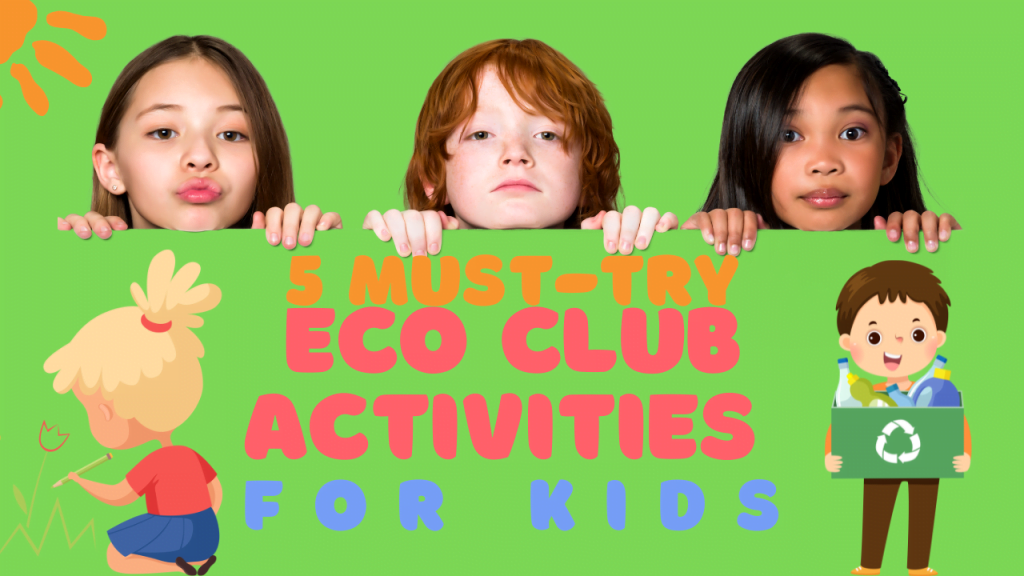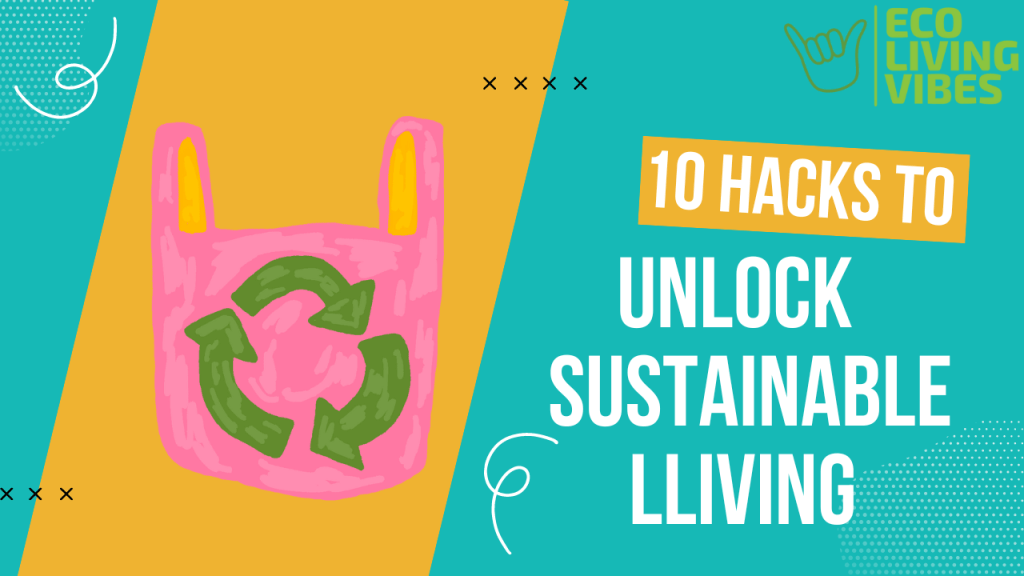Hey there, eco-warriors! Ever thought about how crucial it is to chat about sustainability with our little ones? They’re our planet’s future after all!
Sustainability isn’t just a buzzword; it’s a lifestyle. Introducing it to kids early? Super smart move.
Why, you ask? Here are some juicy tidbits:
- 🎨 It sparks creativity! Imagine turning old newspapers into fabulous art.
- ❤️ Nurtures a genuine love for our big blue planet.
- 🌍 Shapes them into eco-conscious humans, aware of their footprints.
So, if you’re scouting for top-notch eco club activities for kids, you’re in the right hub! Let’s dive deep and explore fun ways to teach sustainability, shall we? Don’t forget to check out our 50+ eco club ideas here

1. Recycled Art Projects: Eco Creativity Unleashed
Alright, eco-enthusiasts, ready to jump into one of the most creative eco club activities for kids? Roll up those sleeves and let’s get started with recycled art!
🔍 Turning Trash into Treasure: A Step-by-Step Guide
Transforming everyday ‘junk’ into art is not just eco-friendly but also a fantastic exercise in creativity for kids. Here’s how to embark on this sustainable artistic journey:
Step 1: Gather Your Materials
It all begins with a treasure hunt around the house. What ‘waste’ can be art?
- Old magazines: Perfect for colorful collages.
- Cardboard: Makes a solid base for any masterpiece.
- Bottle caps, broken toys, fabric remnants: These are your art embellishments!
Top Tip: Organize your materials in clear containers so kids can easily see and choose their resources. This also helps in keeping the workspace tidy.
Step 2: Dream Up a Concept
Encourage your kids to brainstorm. What do they want to create? A cityscape? A self-portrait? The wackier, the better!
Top Tip: Use Pinterest or art websites for inspiration. A visual boost can often trigger the most imaginative ideas.
Step 3: Lay the Foundation
If they’re making a collage, start with a sturdy piece of cardboard as the base. For 3D projects, think about the structure and balance.
Step 4: Add, Build, Create!
Here’s where the magic happens. Glue, stick, fold, or attach the materials onto your base. Kids can layer, overlap, or even dangle items. Remember, there are no rules in art!
Top Tip: Offer a variety of adhesives: glues, tapes, or even string. Different materials bond best with different adhesives.
Step 5: Showcase Your Masterpiece
Finished? Bravo! Now find a spot to show off that artwork. Maybe it earns a spot on the fridge or even framed on the wall?
Top Tip: Hold a mini art exhibition at home. Invite family to view and discuss the artworks. It’s a fabulous way to appreciate the effort and boost a child’s confidence.
Step 6: Reflect and Educate
Take a moment with your child to reflect on the project. Discuss how they turned what many consider ‘waste’ into something unique. It’s not just about the art, but the eco-conscious thinking behind it.
So, the next time someone tosses a magazine or an old toy, your little artist might just say, “Hold on! That’s my next masterpiece!” Creating art, recycling, and building eco-awareness all in one? Yep, that’s the magic of eco club activities for kids!
2. Planting a Mini-Garden: Green Thumbs Begin Small

Okay, green-hearted folks! Let’s dive into one of the most grounding (pun intended) eco club activities for kids—planting a mini-garden. Ready to dig in?
🌱 Little Hands, Green Thumbs: Your Step-by-Step Guide
Planting a garden, even a mini one, teaches kids patience, care, and the sheer joy of watching life sprout from a tiny seed. Here’s how to grow eco-consciousness, one plant at a time:
Step 1: Pick Your Pot
Start with a container. Small pots, recycled jars, or even old boots work wonders!
- Tip: Ensure there’s drainage. Plants dislike soggy feet!
Step 2: Select Your Seeds
Herbs, flowers, or veggies? Choose seeds that are easy for beginners.
- Tip: Basil, sunflowers, or radishes are great starters. They sprout quickly, and kids love quick results!
Step 3: Fill it Up!
Add soil to your chosen container, leaving a little space at the top. Give it a tap to remove air pockets.
- Tip: A mix of potting soil and compost enriches the soil, giving seeds the best start!
Step 4: Plant Those Tiny Treasures
Poke small holes (read seed packet for depth), drop in seeds, and cover them gently with soil.
- Tip: Label your pots if you plant different seeds. It’s a mystery until they sprout otherwise!
Step 5: Water and Wait
Water the soil, making it damp but not soaked. Place the pot in a sunny spot and watch the magic unfold.
- Tip: Too much sun? Move to a shadier spot. Check soil moisture daily.
Step 6: Nurture and Grow
With sprouts emerging, it’s time for TLC! Water as needed, rotate pots for even growth, and enjoy every tiny leaf.
- Tip: Document growth with photos. It’s a fantastic way for kids to see progress!
Step 7: Harvest or Relocate
For veggies, it’s munch time! For plants outgrowing their pots, consider transferring them outdoors or to bigger containers.
- Tip: Celebrate the first harvest. Maybe a pizza topped with homegrown basil?
There you have it—a mini-garden that’s not just about plants but life lessons. Nurturing, patience, and the thrill of growth, all wrapped in eco club activities for kids. Ready for the next planting session? The Earth sure is grateful!
3. Nature-Based Treasure Hunts: Eco Exploration Galore!
Hey nature enthusiasts! Fancy a thrilling outdoor adventure with a green twist? Dive into one of the most exhilarating eco club activities for kids—a nature-based treasure hunt. Let’s unearth nature’s secrets!
🔎 Embarking on an Eco-Quest: Your Guide to Nature’s Treasures
A nature treasure hunt doesn’t just get kids outdoors, but it also sharpens their observation skills and fosters a love for our planet’s wonders. Here’s how to embark on this green expedition:
Step 1: Choose Your Hunting Ground
Parks, forests, beaches, or even your backyard—the world’s your oyster!
- Tip: Familiarize yourself with the location first. Safety first, adventurers!
Step 2: Draft a List of Nature’s Jewels
List down natural items for kids to find: a pinecone, a feather, a smooth stone, or a daisy.
- Tip: Adapt your list based on the location and season. Spring? Look for budding flowers!
Step 3: Set the Rules
Decide if it’s a team event or solo. Will there be time limits? Clues? Or even a map?
- Tip: Younger kids? Opt for visuals rather than written clues. Drawings can be super helpful!
Step 4: Embark on the Hunt
Hand out the lists or clues and let the eco-quest begin! Watch as they scurry with excitement, crossing off items.
- Tip: Ensure kids understand not to harm living plants or creatures. We’re eco-explorers, not pirates!
Step 5: Review and Reflect
Once the hunt’s over, gather to discuss the finds. Who found the most unusual item? Who had the best teamwork?
- Tip: Hold a small ceremony. Handmade ‘Nature Detective’ badges are always a hit!
Step 6: Extend the Experience
Post-hunt, delve deeper. Maybe craft using the found items? Or research a mysterious object?
- Tip: Create a ‘Nature Journal’. Document finds, sketch items, and jot down feelings or learnings.
And voilà! What began as a fun game morphs into a memorable eco-journey. With every hunt, kids don’t just find treasures but also a deeper appreciation for Mother Earth. Ready for another round of eco club activities for kids? The treasures await! If you want more info on how to set up your eco club check out this article.
3. DIY Bird Feeders: Invite the Birds to Your Backyard!

Oh, the joy of waking up to chirping melodies! Whether you’re an avid birdwatcher or just someone who loves nature’s soundtrack, a DIY bird feeder is a fantastic way to connect with the winged wonders right in your backyard. And guess what? We’re turning waste into wonder with this eco club activity for kids!
Materials Needed:
- Old milk cartons or plastic bottles (Clean and dry)
- Birdseed (Choose a mix that’s popular with local bird species)
- String or twine
- Scissors
- Paints and brushes (optional, for decorating)
🦜 Crafting Your Feathered Friends’ Diner: Step-by-Step
Step 1: Prep the Container
Start with a clean, dry milk carton or bottle. Remove any labels or residues. This ensures our bird buddies dine in style and hygiene!
Step 2: Craft the Feeding Windows
Cut out large windows or holes on the sides of the carton/bottle. These are your birdies’ dining doors!
- Tip: Leave ample space at the bottom to hold the seeds. And ensure the openings are large enough for birds but not so big that seeds spill out easily.
Step 3: Add Some Personal Flair
Feeling artsy? Decorate the exterior. Use paints to create vibrant patterns, making it visually appealing for both birds and humans.
- Tip: If you paint, ensure it’s non-toxic and safe for our feathery friends. And allow ample drying time!
Step 4: String It Up!
Poke two holes at the top, string your twine through, and secure a tight knot. This is your hanging mechanism.
Step 5: Fill ‘er Up!
Pour in the birdseed, ensuring it’s easily accessible from the feeding windows.
- Tip: Different bird species prefer different seeds. Do a little research on your local birds and customize the menu!
Step 6: Hang and Observe
Find a serene spot in your garden or balcony. Ensure it’s away from busy pathways (and curious cats!). Hang your DIY feeder and wait for the aerial magic.
- Tip: Place it where you can easily view it from indoors. Birdwatching is therapeutic and educational!
🌿 Benefits of this DIY Delight
Beyond the sheer joy of watching birds, this activity is a triple win:
- **Instilling Kindness to Creatures:** Nurturing empathy as kids learn to care for birds and appreciate their beauty.
- **Observing Local Bird Species:** A first-hand biology lesson as they spot and identify different birds.
- **Recycling Waste:** Teaching the importance of repurposing and reducing waste, one feeder at a time.
So, eco-champions, are you ready to turn trash into a treasure trove for birds? With this simple yet fulfilling activity, we’re not just feeding our feathered friends, but also nourishing young minds with values of care, curiosity, and conservation. Let the birdwatching begin!
Conclusion: Cultivating Green Hearts, One Activity at a Time
Well, eco-warriors, what a journey! Diving deep into these eco club activities for kids has been nothing short of magical. From crafting melodies with nature to unearthing its treasures, every activity paves a path to a greener tomorrow.🌱
But here’s the thing. It’s not just about the fun and games (though they are a HUGE perk!). These activities sow the seeds of eco-consciousness in young minds. They’re lessons of love, care, and respect for our beautiful planet. 🌏
Every recycled piece of art, every sprouting plant, and every nature-made tune is a step towards nurturing a generation that understands and values sustainability. A generation that doesn’t just live on Earth but lives with it.
So, to all the parents, guardians, and young eco-enthusiasts out there: keep the green flame alive. Seek out more eco activities, keep exploring, keep learning. Because every little eco-activity is a promise of a brighter, greener future. 🌟
Until next time, keep those green hearts beating and the planet-loving vibes flowing! The Earth and its future generations thank you! 💚🌍




